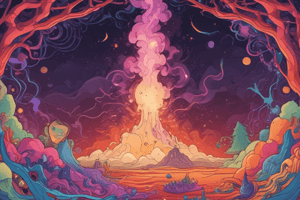Podcast
Questions and Answers
Which of the following is a characteristic of a physical change?
Which of the following is a characteristic of a physical change?
- The original substance changes its form but retains its chemical identity. (correct)
- New substances with unique properties are formed.
- Chemical bonds between atoms are broken and rearranged.
- The chemical composition of the particles changes.
Which process primarily involves the rearrangement of atoms and the formation of new chemical bonds?
Which process primarily involves the rearrangement of atoms and the formation of new chemical bonds?
- Burning wood. (correct)
- Boiling water.
- Dissolving sugar in water.
- Melting an ice cube.
In a chemical reaction, what term is used to describe the substances that are present at the beginning of the reaction?
In a chemical reaction, what term is used to describe the substances that are present at the beginning of the reaction?
- Products
- Reactants (correct)
- Catalysts
- Inhibitors
Which of the following scenarios exemplifies a chemical change?
Which of the following scenarios exemplifies a chemical change?
What is a key difference between physical and chemical changes in terms of reversibility?
What is a key difference between physical and chemical changes in terms of reversibility?
When baking soda reacts with vinegar, what type of substances are created as products?
When baking soda reacts with vinegar, what type of substances are created as products?
Which observation definitively suggests that a chemical change has occurred?
Which observation definitively suggests that a chemical change has occurred?
If a substance undergoes a change where its particles rearrange to form a mixture but do not alter their chemical composition, what kind of change is this?
If a substance undergoes a change where its particles rearrange to form a mixture but do not alter their chemical composition, what kind of change is this?
What happens to the bonds between atoms during a chemical reaction?
What happens to the bonds between atoms during a chemical reaction?
Which of the following best illustrates a physical change that is easily reversible?
Which of the following best illustrates a physical change that is easily reversible?
Flashcards
Physical Change
Physical Change
A change that alters the form or appearance of a substance but not its chemical composition. No new substance is formed.
Chemical Change
Chemical Change
A change that involves the rearrangement of atoms and the breaking/forming of chemical bonds, resulting in new substances.
Reactants
Reactants
Substances that undergo a chemical reaction.
Products
Products
Signup and view all the flashcards
Chemical Reaction
Chemical Reaction
Signup and view all the flashcards
Signup and view all the flashcards
Study Notes
- Physical changes only alter the movement or arrangement of a substance's particles.
- The chemical composition of the particles remains the same.
- No new substances are formed.
- The original substance may change its form, such as its state.
- Substances may combine to form a mixture, such as dissolving.
- The original substances retain their properties.
- Physical changes are easily reversible.
Chemical Changes
- Chemical changes alter the chemical composition of particles.
- Atoms are rearranged into new combinations, forming new chemical substances.
- The chemical composition of the particles changes.
- New substances with unique properties are formed.
- Chemical changes are not easily reversible, as chemical bonds need to be broken.
- Baking soda and vinegar undergo a chemical reaction to form water, carbon dioxide, and salt.
Chemical Reactions
- Start with two substances: vinegar (carbon, oxygen, and hydrogen) and baking soda (sodium, carbon, hydrogen, and oxygen).
- In a chemical reaction:
- Two substances (reactants) chemically react.
- Bonds between atoms break.
- Atoms rearrange and find new partners.
- New bonds are made between the atoms.
- Different substances are formed (products).
Studying That Suits You
Use AI to generate personalized quizzes and flashcards to suit your learning preferences.




